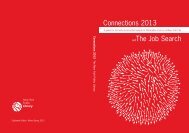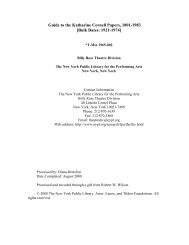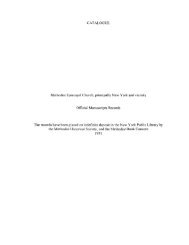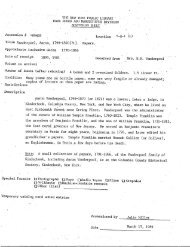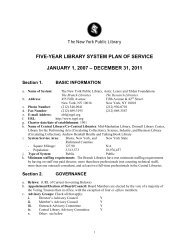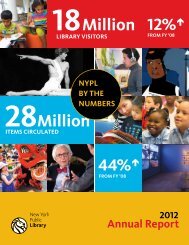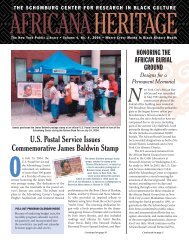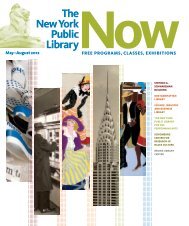Neighborhood Guide: The Lower East Side - New York Public Library
Neighborhood Guide: The Lower East Side - New York Public Library
Neighborhood Guide: The Lower East Side - New York Public Library
You also want an ePaper? Increase the reach of your titles
YUMPU automatically turns print PDFs into web optimized ePapers that Google loves.
: : section 5 : : Construction and Destruction on the <strong>Lower</strong> <strong>East</strong> <strong>Side</strong>: 1933–1934 : : : : section 5 : : Construction and Destruction on the <strong>Lower</strong> <strong>East</strong> <strong>Side</strong>: 1933–1934 : :<br />
<strong>New</strong> <strong>York</strong> City is defined by<br />
change. Those who live here<br />
long enough will see the city<br />
transform before their eyes.<br />
Places are continually being torn down, recreated,<br />
rebuilt, and reused. <strong>The</strong> reasons for this constant<br />
redefinition of <strong>New</strong> <strong>York</strong> City are numerous: <strong>New</strong><br />
technology, increased population, outdated modes<br />
of business, rehabilitation, vanity, overcrowding,<br />
overpricing, abandonment, and decline all contribute<br />
to neighborhood change and propel the people who<br />
make it happen.<br />
<strong>New</strong> <strong>York</strong> City’s <strong>Lower</strong> <strong>East</strong> <strong>Side</strong> has gone through<br />
many of its own transformations, not only in terms of<br />
population, but also in physical scale. Small wooden<br />
tenements were replaced by taller, brick ones, the<br />
destruction of which made way for high-rise middleand<br />
low-income housing complexes, which have been<br />
joined in recent years by other high-rise, luxury apartment<br />
buildings. Subways, parks, and highways have<br />
been built to meet the needs of a growing and more<br />
mobile population. Whatever the reasons that lay<br />
behind construction projects, they are often presented<br />
to address a community need.<br />
In 1933, Knickerbocker Village was constructed on a<br />
block of the <strong>Lower</strong> <strong>East</strong> <strong>Side</strong> that was condemned as<br />
a slum. This block, called the “Lung Block,” between<br />
Catherine, Market, Monroe, and Cherry streets, had a<br />
series of apartments and rooming houses that housed<br />
working families. It was called the “lung block” because<br />
its excessive overcrowding led to rampant disease,<br />
particularly tuberculosis. According to reformer Ernest<br />
Poole, nearly 4,000 people lived on just that block in<br />
1903. Thirty years later, the population was less dense,<br />
but the buildings had not seen much improvement.<br />
<strong>The</strong> plan to erect Knickerbocker Village was pitched<br />
as an opportunity to replace dilapidated housing with<br />
modern, middle-class facilities, allowing for a better<br />
living standard. In order to do so, the existing buildings<br />
were condemned and torn down and families were<br />
displaced. This cycle of condemnation, displacement,<br />
construction, and repopulation fell under the name of<br />
“slum clearance.” Today, slum clearance is often seen<br />
in a negative light, because it disbanded communities<br />
of people who did not want to move and had established<br />
connections and family in its neighborhoods.<br />
Often projects such as Knickerbocker Village replaced<br />
long-time neighborhood residents with more well-todo<br />
<strong>New</strong> <strong>York</strong>ers from other parts of the city. However,<br />
at the time, it was generally seen as a positive force,<br />
ridding the city of areas that were run-down and posed<br />
health hazards.<br />
Like development projects today, Knickerbocker<br />
Village garnered a variety of opinions and generated<br />
debate. This construction project had specific stated<br />
intentions, some of which were fulfilled, and some of<br />
which were not. In can be interesting to consider how<br />
projects were viewed at the time they were created in<br />
relation to our perceptions of these projects today.<br />
Suggested Activities: <strong>The</strong> following resources<br />
each have questions for interpretation and can<br />
be looked at individually or in a group. Images 2–5<br />
are of the before, during and after the building<br />
of Knickerbocker Village. <strong>The</strong> questions that<br />
follow these images are meant to be used for<br />
all three as a group. In addition, you might want<br />
to try some of the suggested activities in the<br />
How to Use This <strong>Guide</strong> section of the resource.<br />
Something to Try: Look back at the map and<br />
print of Rutgers Farm in Section 1. Try to find<br />
where Knickerbocker Village would be on the<br />
map. Look at a map of the area today. How has<br />
the neighborhood changed?<br />
RESOURCES<br />
image 1. Youth learning to gamble on the<br />
Cherry Street sidewalk<br />
NYPL, Manuscripts and Archives Division,<br />
Fred F. French Company Records.<br />
42 43




